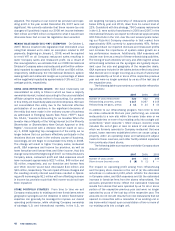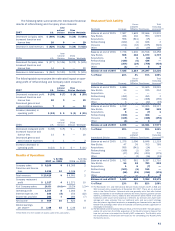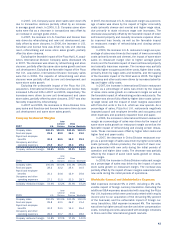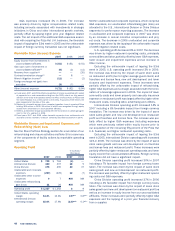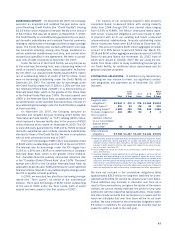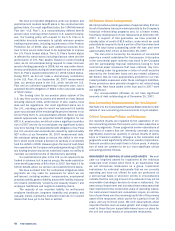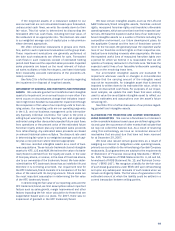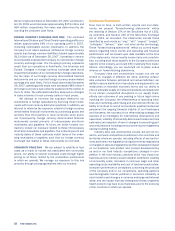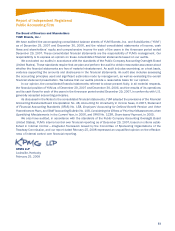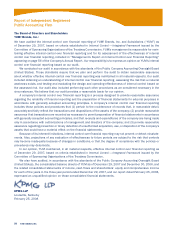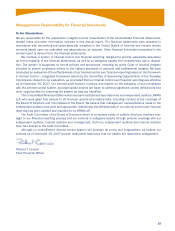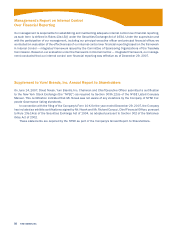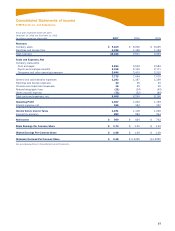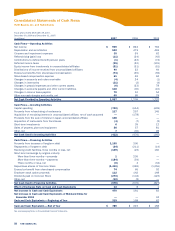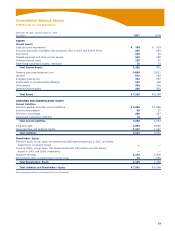Pizza Hut 2007 Annual Report Download - page 46
Download and view the complete annual report
Please find page 46 of the 2007 Pizza Hut annual report below. You can navigate through the pages in the report by either clicking on the pages listed below, or by using the keyword search tool below to find specific information within the annual report.50 YUM! BRANDS, INC.
If payment on the guarantee becomes probable and esti-
mable, we record a liability for our exposure under these lease
assignments and guarantees. At December 29,2007, we have
recorded an immaterial liability for our exposure which we
consider to be probable and estimable. The potential total
exposure under such leases is significant, with approximately
$325 million representing the present value, discounted at our
pre-tax cost of debt,of the minimum payments of the assigned
leases at December 29, 2007. Current franchisees are the
primary lessees under the vast majority of these leases. We
generally have cross-default provisions with these franchisees
that would put them in default of their franchise agreement in
the event of non-payment under the lease. We believe these
cross-default provisions significantly reduce the risk that we
will be required to make payments under these leases and,
historically, we have not been required to make such payments
in significant amounts.
See Note 2 for a further discussion of our policies regard-
ing franchise and license operations.
See Note 22 for a further discussion of our lease
guarantees.
SELF-INSURED PROPERTY AND CASUALTY LOSSES We record
our best estimate of the remaining cost to settle incurred
self-insured property and casualty losses. The estimate is
based on the results of an independent actuarial study and
considers historical claim frequency and severity as well as
changes in factors such as our business environment, ben-
efit levels, medical costs and the regulatory environment that
could impact overall self-insurance costs. Additionally, a risk
margin to cover unforeseen events that may occur over the
several years it takes for claims to settle is included in our
reserve, increasing our confidence level that the recorded
reserve is adequate.
See Note 22 for a further discussion of our insurance
programs.
PENSION PLANS Certain of our employees are covered under
defined benefit pension plans. The most significant of these
plans are in the U.S. In accordance with SFAS No. 158
“Employers’ Accounting for Defined Benefit Pension and Other
Postretirement Plans” (“SFAS 158”), we have recorded the
under-funded status of $110 million for these U.S. plans as
a pension liability in our Consolidated Balance Sheet as of
December 29, 2007. These U.S. plans had projected benefit
obligations (“PBO”) of $842 million and fair values of plan
assets of $732 million in December 29, 2007.
The PBO reflects the actuarial present value of all benefits
earned to date by employees and incorporates assumptions
as to future compensation levels. Due to the relatively long
time frame over which benefits earned to date are expected
to be paid, our PBO’s are highly sensitive to changes in dis-
count rates. For our U.S. plans, we measured our PBO using a
discount rate of 6.50% at September 30, 2007. This discount
rate was determined with the assistance of our independent
actuary. The primary basis for our discount rate determina-
tion is a model that consists of a hypothetical portfolio of
ten or more corporate debt instruments rated Aa or higher
by Moody’s with cash flows that mirror our expected benefit
payment cash flows under the plans. In considering possible
bond portfolios, the model allows the bond cash flows for
a particular year to exceed the expected benefit cash flows
for that year. Such excesses are assumed to be reinvested
at appropriate one-year forward rates and used to meet the
benefit cash flows in a future year. The weighted average
yield of this hypothetical portfolio was used to arrive at an
appropriate discount rate. We also insure that changes in
the discount rate as compared to the prior year are consis-
tent with the overall change in prevailing market rates and
make adjustments as necessary. A 50 basis point increase
in this discount rate would have decreased our U.S. plans’
PBO by approximately $65 million at our measurement date.
Conversely, a 50 basis point decrease in this discount rate
would have increased our U.S. plans’ PBO by approximately
$71 million at our measurement dates.
The pension expense we will record in 2008 is also
impacted by the discount rate we selected at our measure-
ment date. We expect pension expense for our U.S. plans to
decrease approximately $19 million to $37 million in 2008.
The decrease is primarily driven by a decrease in amortization
of net loss of $17 million in 2008. A 50 basis point change in
our weighted average discount rate assumption at our mea-
surement date would impact our 2008 U.S. pension expense
by approximately $10 million.
The assumption we make regarding our expected long-
term rates of return on plan assets also impacts our pension
expense. Our estimated long-term rate of return on U.S. plan
assets represents the weighted-average of historical returns
for each asset category, adjusted for an assessment of cur-
rent market conditions. Our expected long-term rate of return
on U.S. plan assets at September 30, 2007 was 8.0%. We
believe this rate is appropriate given the composition of our
plan assets and historical market returns thereon. A one per-
centage point increase or decrease in our expected long-term
rate of return on plan assets assumption would decrease or
increase, respectively, our 2008 U.S. pension plan expense
by approximately $7 million.
The losses our U.S. plan assets have experienced, along
with a decrease in discount rates over time, have largely con-
tributed to an unrecognized net loss of $80 million included
in Accumulated other comprehensive income (loss) for the
U.S. plans at December 29, 2007. For purposes of deter-
mining 2007 expense, our funded status was such that we
recognized $23 million of this loss in net periodic benefit
cost. We will recognize approximately $6 million of such loss
in 2008.
See Note 16 for further discussion of our pension and
post-retirement plans.


